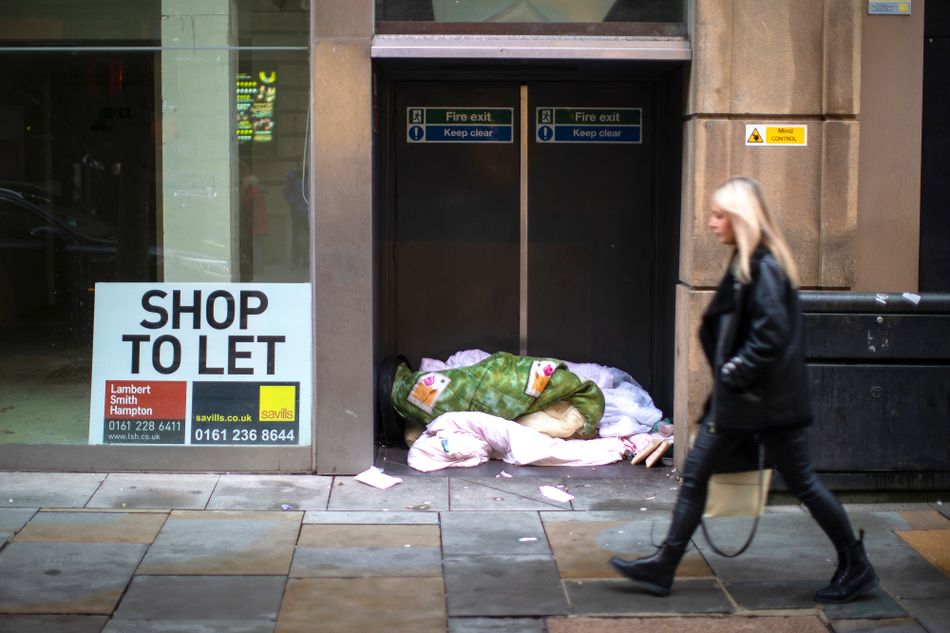“I’m never going to do the Facebook post of me holding the house keys to my own house. I’m never going to have that feeling—I won’t know what it’s like.” Emma (not her real name) works with refugees and lives with her teenage son in a two-bedroom house. She rents her home privately from a Manchester housing association on a market rent scheme. She has been temporarily signed off from work because of stress, even though she loves her job.
The problem is her housing or, more specifically, the unaffordability of her housing. A letter from her landlord raising the rent in January turned her world upside down. After fleeing from domestic abuse, she was happy to have found a quiet, comfortable flat in Levenshulme in the south of Manchester. But when the rent increased to an amount she couldn’t afford, she began to doubt herself.
“The thoughts that would come into my head when I was trying to sleep were like, ‘What was I thinking? What was I thinking, settling here, and starting a life of stability here for my son?’” she says. “We don’t belong here. We haven’t got enough money to belong here. This street… it’s next to a country park. It was unrealistic. And I felt angry with myself for thinking that we could have those things.”
Many people like Emma are stuck in the middle of two interlocking crises. One is the cost-of-living crisis sparked by escalating energy bills (rising by an average of £693 annually for households on standard tariffs and £708 for those on prepayment meters); skyrocketing fuel costs (currently £1.79 per litre for petrol and £1.85 per litre for diesel); and inflation (forecast to reach 10 per cent by the end of the year).
The second is a crisis that no longer feels like a crisis, so entrenched has it become: the rising cost of our housing. The average house in the UK now costs more than eight times the average annual salary of £31,772, similar to the ratio in the late 1800s. An ever-dwindling stock of social housing is treated as the new normal—while the fact that two-fifths of renters are struggling to pay their housing costs (as estimated by the ONS in a recent report) is regarded as an ordinary state of affairs.
But the consequences of long-term housing precarity are grave. For years, millions of low-income households have been teetering on the cliff edge; the soaring cost of living threatens to topple them off. About 1.3m people are predicted to plunge into absolute poverty next year, including 500,000 children as councils warn that they will face a tidal wave of homelessness. The government’s recent package of measures—a doubling of help with energy bills to £400 and a one-off cost-of-living payment of £650 to 8m of the lowest-income households —is welcome. However, these piecemeal interventions do nothing to address the fundamental problem that people cannot afford their housing. As Matt Downie, the chief executive of Crisis, says: “Housing is at the root of the cost-of-living crisis, but up to now has been ignored.”
For years, millions of low-income households have been teetering on the cliff edge; the soaring cost of living threatens to topple them off.
The government’s proposed solution is to revive the Right to Buy scheme by extending it to housing association tenants—an idea that Polly Neate, the chief executive of Shelter, described as “hare-brained.” Boris Johnson has boldly claimed that every home sold will be replaced. Back in May, however, the Chartered Institute for Housing expressed concern that the policy “would lead to a reduction in the overall number of affordable homes,” saying that “we need to be focused on building more social homes, not selling off existing stock.”
High rents for poor housing
Many of the lowest-income people in the UK are renting, either from social housing providers (like housing associations) or from private landlords. I spoke to housing charities across the country who support clients facing unaffordable rents for substandard housing. They’ve found that, at the same time as energy bills spiral upwards, rents are rapidly increasing too. “When rent costs so much of a person’s outgoings, that is already putting people into a financially precarious state where additional bills—energy prices—are a lot more difficult to manage,” says Isaac Rose, an organiser for the Greater Manchester Tenants Union.
“On top of that, we’re also seeing quite rapid rent rises in the private rented sector. This is across the board nationally, but in Manchester… we’ve had a number of cases where tenants have been faced with a rise of 20 per cent or more.” I ask him whether this is a wise strategy for landlords, given the ONS data showing many are already struggling to pay their rent owing to escalating costs. How can rent keep going up if people aren’t able to pay it? “In Manchester particularly the population is growing,” he says, “and I think those who can’t pay in the private rented sector will either be forced into temporary accommodation sectors, or they’ll be forced to leave Manchester and move to a cheaper area.”
Joey Carr, a caseworker at housing charity Safer Renting, reports a similarly grim picture in London, where low-income tenants are resorting to desperate measures to rent a home in the city. One client she supported was using the entirety of his universal credit payment to pay his rent for several months, leaving him with nothing to spend on essentials. He then had a stroke, due to an underlying condition that had been exacerbated by stress. After being admitted to hospital, he returned home to find he had been illegally evicted and his belongings thrown onto the street. He is now living in temporary accommodation provided by the council, along with (according to estimates by cross-party organisation London Councils) another 165,000 Londoners.
Tenants in Birmingham are likewise facing a worrying squeeze. “The market rents outstrip what people get with housing benefit, and that needs to change,” says Matt Green, the director of Crisis’s Skylight Centre, which provides education, health and housing services for homeless people in the city. Green is worried that the cost-of-living crisis will push people into homelessness who would otherwise have never experienced it, with families that are already living on the breadline at the highest risk. Crisis research suggests that 69 per cent of low-income households will have to go without essentials—food and heating—for at least one day a week to keep up with rising living costs. “In Birmingham, it’s [the] equivalent of nearly a day and a half,” he tells me.

Safety net or booby trap?
The safety net that should be provided by the benefits system—now streamlined through universal credit—does not catch everyone who is struggling. Roni Marsh is the leader of the money advice team at community legal aid practice South West London Law Centres. She explains that before the cost-of-living crisis hit, many of her clients were already in deficit budgets—their income was insufficient to cover their essentials, leaving them forced to choose which of their bills to pay.
The team’s typical client is, the law centre says, “a council tenant, [who] is only spending money on food, toiletries and pet food. He is relying on discretionary funds, such as a fuel voucher here and there, just to stay afloat and pay his bills. He uses the food bank for food and toiletries and relies on free church lunches for his socialising. He sees no way of coping once the discretionary funds stop or without the free advice from charities to help him apply for emergency grants.”
Almost all of Marsh’s clients are receiving universal credit, even though many are working full-time. For some, the bedroom tax, introduced by the coalition in 2013, means they do not receive enough housing support to pay their rent. Social housing tenants who are deemed to have one more bedroom than necessary based on the size of their household lose 14 per cent of their housing payment, and those with two or more rooms lose 25 per cent. “On a subsistence-level benefit already, that’s unsustainable,” Marsh says. “They say, ‘Oh well, you can downsize,’ but there aren’t any smaller social housing properties at the moment to downsize into, so you’re just stuck.”
When rents are too high and the safety net isn't catching those who need it, what happens?
Another issue for vulnerable tenants is that the benefits that they do receive can end up in the pockets of unscrupulous landlords providing substandard accommodation. In fact, vast amounts of taxpayers’ money is estimated to be boosting such landlords’ profits. A particular problem is the “exempt accommodation” sector which, according to the magazine Inside Housing, is “shared housing that is not funded or commissioned by local authority or social care funding.” It is often used to house people who have few other options, such as prison leavers, people with mental health or substance abuse problems, or refugees languishing on long waiting lists for a council property or stuck in temporary accommodation. Operating entirely separately from the local authority statutory homeless system, the sector has been described by Crisis as “dangerously unregulated.”
The reason “exempt accommodation” can be so lucrative for landlords is that its providers are not subject to the Local Housing Allowance benefit caps normally used to determine the maximum rent that a tenant on universal credit can pay—meaning landlords on the scheme can charge higher rents. This exemption is offered on the condition that the provider also offers support such as mental health care to its tenants in addition to the housing itself.
The problem in Birmingham, explains Matt Green, is that some landlords pocket the higher rents while providing poor-quality housing—and little, if any, of the promised care. “Some landlords see it as a bit of a cash cow,” Green tells me. Inside Housing describes Birmingham as “the capital” of this kind of accommodation, with 8,427 properties rented through the scheme. Green also has concerns about safeguarding: there are reports of domestic abuse victims being placed in properties with perpetrators. While he is clear that well-managed exempt providers are an important part of the solution to homelessness—and his charity wants to work with them to improve the standards in the sector—currently there are “millions and millions, probably billions” of pounds of housing benefit going into a system that isn’t solving the city’s housing crisis.
Teetering on the edge
When rents are too high and the safety net isn’t catching those who need it, what will happen to people squeezed by both the cost of living and the housing crisis?
For Emma, the future is “terrifyingly” unclear. With the help of her local branch of the Greater Manchester Tenants Union, she was able to negotiate a compromise with her landlord—she will pay a smaller rent increase for now. But while this means she can afford to remain in the flat in the short term, she is still panicking. “I’ve realised that it’s a dog-eat-dog housing world out here… I can’t imagine how many instances of homelessness have been created by greed.”
She has already started adapting to the rising cost of living, changing the brands of her toilet roll and “going nuts about switching things off at the wall.” She is also rationing the use of her car, for work meetings and medical appointments only. She has been forced to limit some of her son’s extra-curricular activities and has taken out another credit card while they adjust to “a much lower income that doesn’t meet our needs, because of how much it’s costing to carry on paying for the things that we already had.”
Will this be enough to keep Emma and her son in their home? She doesn’t “even want to think about what happens... when I have the same fight with my landlord” again. She has no idea by how much they will increase the rent next time.
Squeezed by her housing and living costs, Emma is angry and scared. “I think that our government has proved that human beings are collateral damage… and in terms of what happens in the future? I don’t know.”













